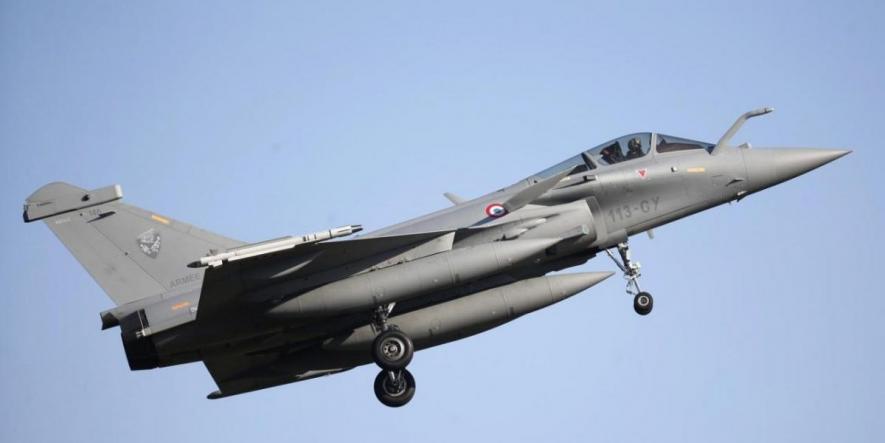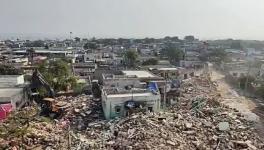Rafale Judgement Raises Serious Questions

Image Courtesy: The Wire
“There is no greater tyranny than that which is perpetrated under the shield of the law and in the name of justice.” ― Charles-Louis de Secondat, baron de la Brède et de Montesquieu, The Spirit of the Laws.
The Supreme Court of India has pronounced its verdict on Prime Minister Narendra Modi’s Rafale deal. A number of petitions questioned the procedural violations by the Prime Minister himself and the exorbitant price decided by a group of Cabinet Ministers who don’t have any expertise in the subject matter to take such a call. For most people who followed the deal and the case, the Supreme Court’s order on Friday didn’t come as a surprise because since last couple of years, in almost all the cases where the misdeeds of the senior functionaries of the executive were questioned, the higher judiciary’s orders were on similar lines.
Read more: Rafale Deal: Why Did the Modi Government Rush to get CCS Approval?
Let us check what this order says and what the court didn’t consider while deciding the case.
The basic premise of the case is the alleged procedural violation by the Prime Minister of the country. The government told the court that the process for the withdrawal of Request for Proposal (RFP) began in March 2015, and the court accepted this argument. This seems strange for many reasons.
The order says, quoting from the Defence Procurement Procedure (DPP): “Any deviation from the prescribed procedure will be put up to DAC (Defence Acquisition Council) through DPB (Defence Procurement Board) for approval”
Modi made the announcement on April 10, 2015.
However, the government’s reply is silent on when the decision was taken to reduce the required number of aircraft from 126 to 36 – which is not even two full squadrons, and who decided it.
According to the government, DAC approval for the Inter-Governmental Agreement (IGA) was given on May 13, 2015, but it is silent on the much-needed initial approval for the announcement itself. So, when did the Indian Air Force (IAF) send the revised proposal? When did DPB approve it? When was it forwarded to the DAC and when did DAC approve it? Strangely, the court did not ask this to the government. For any defence procurement – whether it is through a tender or a direct purchase – this basic procedure must be followed. The court has completely ignored this very basic premise.
Read more: Rafale Deal: Govt’s Reply to SC Reads More Like a Cover-up for PM Modi’s Culpability
In March 2015, as per a Video posted by Dassault Aviation on its website, and according to different statements at press conferences issued by Dassault CEO Eric Trappier, negotiations were very much on between the Government of India and Dassault Aviation in March 2015, and were 95 per cent completed. Though this evidence is there for everyone to see, and was highlighted by the petitioners (Yashwant Sinha, Arun Shourie and Prashant Bhushan). It seems, the apex court forgot to ask what prompted the government to start the process to cancel the RFP which was 95 per cent negotiated?
As per people in the know, the then Defence Minister Manohar Parrikar came to know about the plan to cancel the RFP and purchase 36 Rafale in fly-away condition only on April 3, evening. This was widely published. Then who decided and initiated the process to cancel the RFP in March 2015 without informing the Defence Minister of the country? Isn’t it strange that the two most important people related to such a deal – the Indian Defence Minister and the CEO of the company with which GoI was negotiating – were not aware of such a decision by the government of India?
There is another glaring lapse. The reply that the government submitted to the court liberally quoted from the preamble to the DPP, and said that the process was done according to DPP 2013. Interestingly, DPP 2013 or any DPP prior to that did not have a preamble. The preamble to the DPP was added only in 2016.
The court’s order cites: “As far as the endeavour to procure 126 fighter aircraft is concerned, it has been stated that the contract negotiations could not be concluded, inter alia, on account of unresolved issues between the OEM and HAL”, and it quotes two reasons from government’s reply: “i) Man Hours that would be required to produce the aircraft in India: HAL required 2.7 times higher Man Hours compared to the French side for the manufacture of Rafale aircraft in India. ii) Dassault Aviation as the seller was required to undertake necessary contractual obligation for 126 aircraft (18 direct flyaway and 108 aircraft manufactured in India) as per as the reason for the cancellation of the RFP requirements. Issues related to contractual obligation and responsibility for 108 aircraft manufactured in India could not be resolved.”
But there are two things that were overlooked by admitting this argument.
The French media reported way back in March 2014, quoting Trappier, that Dassault Aviation had reached an agreement with HAL on “general configuration of the aircraft, the technology transfers and the detailed workshare between the two partners and their subcontractors. Also, it clarifies the mechanism for handling warranties.”
In March 2015, when the government says they initiated the process to cancel the RFP, Trappier told French media: "This is the first time Dassault agrees to be a co-contractor. Dassault and HAL will both take responsibility for the part they will each build on the Rafale aircraft made in India.”
In India, former HAL Chairman Suvarna Raju had said this: “You have to see the life-cycle costs and not the cost per piece of a fighter. Life-cycle costs would have definitely been cheaper. And ultimately it’s about self-reliance. Dassault and HAL had signed the mutual work-share contract and given it to the government. Why don’t you ask the government to put the files out in public? The files will tell you everything. If I build the planes, I will guarantee them.”
Though petitioners pointed this out, the court, for reasons known to it, neither considered these arguments nor asked the government to submit the files that Suvarna Raju mentioned for verification.
Read more: EXCLUSIVE: Flying Lies?
The Ministry of Defence’s (MoD) communication with Ministry of Law and Justice (MoLJ) shows serious compromises on the part of the Modi government in securing India’s interests in the IGA, as well as interferences from National Security Advisor Ajit Doval in the working of Indian Negotiating Team (INT) and Contract Negotiation Committee (CNC). This has been pointed out in detail here.
It was evident from the published articles and verified government documents that the Cabinet Committee on Security, which comprises the PM and four cabinet ministers, took the decision to hike the price from 5.2 billion to 8.2 billion Euros. Unfortunately, by the time these documents were verified, the court had heard the arguments and reserved its verdict. And the dissent note of three senior-most members of the negotiating team was not even considered by the court. Their forceful transfer for refusing to sign Modi’s price has also not been looked into.
The order says: “The pricing details have, however, been shared with the Comptroller and Auditor General (hereinafter referred to as “CAG”), and the report of the CAG has been examined by the Public Accounts Committee (hereafter referred to as “PAC”). Only a redacted portion of the report was placed before Parliament and is in public domain.”
Some PAC members have confirmed that the CAG audit report was not shared with them, leave alone examining it. This shows that the government of the day did not disclose the truth to the highest court of the country, and court trusted their words while writing the judgment. This shows how flawed this judgement is.
But, in the case of choice of Indian offset partner (IOP), the court has taken former French President Francoise Hollande’s revelations very lightly while making the observation that the “press release suggests that there was possibly an arrangement between the parent Reliance company and Dassault starting from the year 2012”. Who is this parent Reliance company, when the court itself observed that Dassault signed a contract with Mukesh Ambani’s Reliance group in 2012, and this is another company? Even if we agree with government’s argument that they did not have any say in the IOP partner of Dassault, why did the government amend clause eight of the offset policy retrospectively after Dassault started a discussion with Anil Ambani’s Reliance group in 2015?
At the end of it, the judgment could be interpreted to imply:
1) News reports based on facts are people’s perceptions.
2) If a former head of a foreign country with whom the GoI negotiated a defence procurement deal points out any angle of corruption in that particular deal, it should be taken as his perception.
3) If any future PM of the country announces any defence deal in violation of procedures, he should not be questioned.
4) Taxpayers don’t have the right to know the commercial value of defence deals because it might affect national security.
5) Future governments can sign “secrecy agreements” with other countries to not disclose the financial details of defence contracts.
6) In defence deals, a PM and his cabinet can decide the price they want.
7) DPP is nothing, but a bunch of papers.
(Ravi Nair broke the story of the Rafale scam and is writing a book on the subject. Views expressed in this write-up are personal.)
Get the latest reports & analysis with people's perspective on Protests, movements & deep analytical videos, discussions of the current affairs in your Telegram app. Subscribe to NewsClick's Telegram channel & get Real-Time updates on stories, as they get published on our website.
























